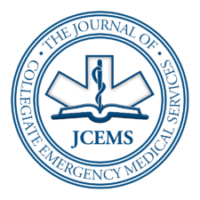Home Authors Posts by Nicholas M.G. Friedman, BA, EMT-B; Brittany J. Dingler, BA, PA-S; Jose V. Nable, MD, MS, NRP; George J. Koenig, DO, MS
The Journal of Collegiate Emergency Medical Services (JCEMS) [ISSN 2576-3687] is the official scholarly, peer-reviewed journal of the National Collegiate Emergency Medical Services Foundation.
Contact us: jcems@jcems.org
© Articles are distributed under CC BY 4.0 License. All other content copyrighted by the National Collegiate Emergency Medical Services Foundation. All rights reserved.






